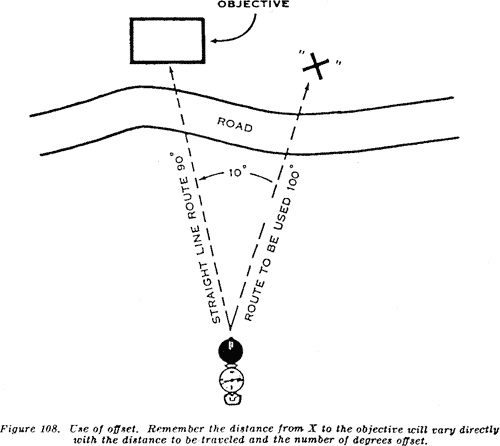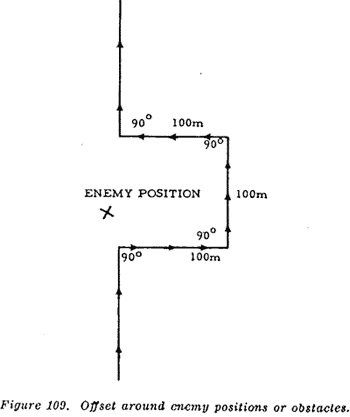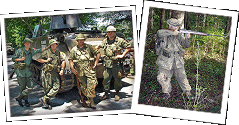Patrol Tips
From Combat Training of the Individual Soldier and Patrolling, July 1967
Section 1. PREPARATION
- Make a detailed map study and know the terrain over which you will pass, especially the terrain in the objective area.
-
Select your route carefully; consider the use of difficult terrain. Terrain is seldom impassible to a determined patrol. Plan an "off-set" in your route if this will assist in locating the objective. (An offset is a planned deviation lo the right or left of the straight line azimuth to the objective.) Use it to verify your location right or left of the objective. Each degree you offset will move you about 17 meters to the right or left for each 1,000 meters you travel (figs. 108-109).


- If possible, take subordinate leaders with you on reconnaissance.
- When appropriate to the mission, arrange to have a light aircraft reconnoiter ahead of the patrol to keep you informed of any enemy activity along your route and act as radio relay when required.
- Consider all types of grenades: fragmentation, white phosphorus, concussion, and smoke, together with the use of the grenade launcher.
- Reconnaissance patrols should carry at least one automatic weapon. It provides valuable sustained firepower.
- Avoid taking weapons requiring different types of ammunition. It makes ammunition redistribution difficult.
- Carry individual weapons cleaning equipment on all patrols.
- Carry gloves to protect hands.
- Carry at least two flashlights and two each of such critical items as binoculars, wire-cutters, and fuze crimpers.
- Carry extra flashlight and radio batteries on long patrols.
- Every man should carry his canteen and poncho. Consider having each man carry two canteens on long patrols. If special circumstances make it undesirable for every man to carry his canteen and poncho, carry at least two of each in the patrol. Ponchos can be used to construct rafts, shelters, and litters, and to conceal lights.
- Have every man carry extra socks.
- Harness should be worn when the weapons belt is worn.
- Consider the use of scout dogs, if available.
- Use friction tape to secure rifle swivels, sling, and other items which might rattle.
- Be sure to camouflage the back of the neck, behind the ears, and the back of the hands.
- Provide for security by assigning every man an area of responsibility.
- Designate at least two pacers and use the average of their individual counts.
- Fold maps before departing so they can be more easily handled when checking.
- Preset compasses before departing. Preset more than one compass for each setting required.
- Prepare a list of questions or a checklist to be used at friendly positions with which you will coordinate.
- Consider the use of field expedient antennas to increase radio range.
- A length of rope secured to the harness can be used for binding prisoners, climbing or descending obstacles, and crossing streams.
- Carry a grappling hook, with a 30-foot length of 1/4-inch rope. This can be used to dislodge items that may be boobytrapped, such as pieces of equipment, weapons, covers of"spider holes," and doors of tunnels. This is particularly useful in counterguerrilla operations. An expedient hook can be made of large, bent nails or very heavy wire.
- Two pieces of luminous tape, 1/2 inch by 11/2 inch, and 1 inch apart, pinned or sewed to the underside rear center of the collar aid in control and movement "on dark nights. Turn the collar down when near the enemy. When the soft field cap is worn the tape may be pinned or sewed at the rear center of the cap 1/2 inch above the bottom edge; cover or remove it when near the enemy.
- Become as familiar as possible with the sounds of birds and other animals in your area of operations, especially the sounds they make when disturbed. This applies to both wild and domestic birds and animals and is particularly useful in counterguerrilla operations. These sounds may warn you of the enemy's approach or presence. They may also alert the enemy to your approach or presence.
- Use available visual aids in issuing your patrol order. The use of a blanket board, blackboard, or a sketch on the ground is helpful.
- Prearrange and rehearse all signals to be used. Keep signals simple.
- Plan time for patrol members to dark-adapt their eyes if you have a night patrol.
- Clean, check, and test fire all weapons before departure.
- Conduct rehearsals on terrain similar to that over which you will operate. Conduct day and night rehearsals. for a night patrol.
- Inspect your patrol carefully before rehearsals and before departure. Question men to check their knowledge and understanding of the actions planned.
- Be sure that maps are not marked with information that might aid the enemy.
Section II. EXECUTION
- On small patrols, the count should be sent up automatically after each halt or passage of a danger area. In large patrols, use the chain of command to account for men.
- Use the point for security and not for navigation.
- Check navigation frequently. You are responsible.
- On long patrols, change point and compass men occasionally.
- Use an alternate challenge and password outside friendly areas.
- In mountainous terrain, use ridgelines for movement whenever possible, but do not move along ridgetops. Stay off the skyline.
- Weapons are always carried at a ready position.
- Cut enemy wire only when necessary. Make a reconnaissance first.
- When moving at night, take advantage of any noises such as wind; vehicles, aircraft, battle sounds, and even sounds caused by insects.
- Do not move on roads and trails unless absolutely necessary.
- Aid movement in daylight, especially in dense terrain, by using night compass settings.
- Avoid all human habitations.
- Bypass enemy positions or obstacles by offsetting around them. Stay oriented by moving at right angles for specified distances. For example, you are moving on an azimuth of 360° and wish to bypass an obstacle or position. Change direction to 90° and move for 100 meters, change direction back to 360° and move for 100 meters, change direction the 270° and move for 100 meters then change direction to 360° and you are back on your original route.
- Avoid lateral movement across the forward portion of the enemy area.
- Over short distances such as the width of a road, the compass can be used for signaling at night. A piece of luminous tape can also be used.
- Crossing roads in enemy territory is a
matter of common sense. Each situation may
dictate a different method. You will not violate
established procedure if you properly reconnoiter
before crossing the road. Establish adequate
security and move silently and quickly to avoid
detection. A main point of consideration in any
road crossing is control of your unit. Some of
the accepted methods for crossing roads are:
- Patrol can form a skirmish line and move quickly and quietly across the road.
- The entire patrol can form a file, following the footsteps of the man in front in order to minimize footprints.
- Men cross the road a few at a time until patrol is across.
- Crossing streams is similar to crossing roads; reconnaissance and security are necessary.
- Break contact with the enemy by the "clock system," by fire and movement, by a combination of both, or by an immediate action drill.
- Know your location at all times. This is particularly important when you change direction and when you land on an airmobile or water-borne patrol. A relatively slight error can cause you to miss your objective.
Section III. MISCELLANEOUS
- Keep the cutting edge of the entrenching tool extremely sharp. It is a good silent weapon and can be used in lieu of a machete.
- A garrote can be used for killing a sentry or capturing a prisoner.
- Do not jeopardize security by letting ear flaps and hoods interfere with the hearing ability of the patrol.
- Keep talking to a minimum. Use arm-and-hand signals to the maximum.
- When reconnoitering enemy positions, keep a covering force within supporting distance of the reconnaissance element.
- Never throw trash on ground while on patrol. Bury and camouflage it to prevent detection by the enemy.
- When contacting friendly agents such as partisans, never take the entire patrol to make contact. Have one man make the contact and cover him.
- Dark, rainy, windy nights are best for patrols.


